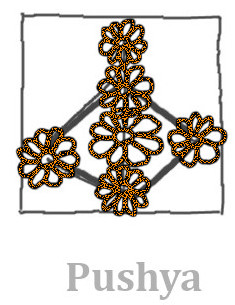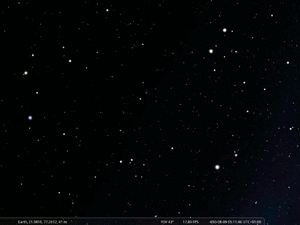Pushya: Difference between revisions
No edit summary |
No edit summary |
||
| (2 intermediate revisions by the same user not shown) | |||
| Line 1: | Line 1: | ||
{{DISPLAYTITLE:}} |
{{DISPLAYTITLE:Puṣya (पुष्य)}} |
||
[[File: |
[[File:Pushya nakshatras in Temple draw+lbl 4ase.jpg|thumb|Pushya, 8th nakshatra, temple ... ]] |
||
[[File:8 Pushya stellarium.gif|thumb|Pushya, 8th Nakshatra, drawn as an arrow in Cancer.]] |
[[File:8 Pushya stellarium.gif|thumb|Pushya, 8th Nakshatra, drawn as an arrow in Cancer.]] |
||
Puṣya (पुष्य) is an Indian name, used by the Indian Vedic tradition. Most of these names are roughly 3000 years old. They pre-date Hinduism but were taken over by it. Pushya is identified with the stars γ, δ and θ Cancri that surround the star cluster M44. |
|||
==Etymology and History== |
==Etymology and History== |
||
'''Name Variants''' |
|||
| ⚫ | |||
* Puṣya, |
|||
* Pushya |
|||
* Sidhya |
|||
* Tiṣya |
|||
| ⚫ | |||
=== Origin of Constellation === |
=== Origin of Constellation === |
||
| ⚫ | |||
| ⚫ | Yet, as the image found in historical depictions is an arrow with only one (bright) star, it suggests that the feathers of the arrow actually represent the group in and around M44. The bright star is α CMi ([[Procyon]]) that rises simultaneously with the faint stars in Cancer was likely used as a marker for them, in particular during twilight observations. Thus, the arrow could be the imagined line between the actual nakshatra group and the observed bright star as indicator. |
||
=== Transfer and Transformation of the Constellation === |
=== Transfer and Transformation of the Constellation === |
||
<gallery> |
|||
File:Pushya nakshatras in Temple draw+lbl 4ase.jpg|Pushya, 10th century CE |
|||
File:Nakshatra temple magDraw lbl.jpg|Display of all 28th nakshatras in silver arch with candles in Tirupperunthurai (Athmanathaswamy temple) near Aranthangi, India, 10th century CE. (SMH 2025). |
|||
File:Nakshatras in Temple draw+lbl 4ase.jpg|Display of all 28th nakshatras in a door frame in Tirupperunthurai (Athmanathaswamy temple) near Aranthangi, India, 10th century CE. (SMH 2025). |
|||
File:Tibet nakshatra 06.png|Pushya, Tibetean |
|||
File:鬼宿(仏像図彙).png|Pushya, Chinese |
|||
File:8 Pushya draw.png|Pushya as reconstructed by Jones (1720) |
|||
</gallery> |
|||
== Mythology == |
== Mythology == |
||
Latest revision as of 08:18, 31 October 2025
Puṣya (पुष्य) is an Indian name, used by the Indian Vedic tradition. Most of these names are roughly 3000 years old. They pre-date Hinduism but were taken over by it. Pushya is identified with the stars γ, δ and θ Cancri that surround the star cluster M44.
Etymology and History
Name Variants
- Puṣya,
- Pushya
- Sidhya
- Tiṣya
Origin of Constellation
The term literally means "the Nourisher" and therefore causes the same association of the star cluster in Cancer like the Greek "manger" that survives in the Latin name of the star cluster M44: Praesepe.
Yet, as the image found in historical depictions is an arrow with only one (bright) star, it suggests that the feathers of the arrow actually represent the group in and around M44. The bright star is α CMi (Procyon) that rises simultaneously with the faint stars in Cancer was likely used as a marker for them, in particular during twilight observations. Thus, the arrow could be the imagined line between the actual nakshatra group and the observed bright star as indicator.
Transfer and Transformation of the Constellation
Mythology
mnemonic tales and cultural significance
Weblinks
References
- References (general)











